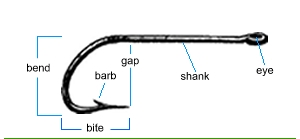Angling
Angling is a method of fishing by means of an "angle" (fishing hook). The hook is usually attached to a fishing line and the line is often attached to a fishing rod. Modern fishing rods are usually fitted with a fishing reel that functions as a mechanism for storing, retrieving, and paying out the line. The hook itself can be dressed with baits or lures to attract fish. Angling is a principal method of sport fishing, but commercial fisheries also use angling methods such as longlining or trolling.
History[edit | edit source]
The practice of angling dates back to ancient times. It is depicted in various ancient art forms, including ancient Egyptian paintings and Chinese artworks. The earliest English essay on recreational fishing was published in 1496, by Dame Juliana Berners, the prioress of the Benedictine Sopwell Nunnery. The essay was titled The Treatyse of Fysshynge wyth an Angle as part of the Book of Saint Albans.
Techniques[edit | edit source]
Angling techniques vary by the type of fish being targeted, the habitat in which the fish live, and the type of water (freshwater or saltwater). Some common angling techniques include:
- Fly fishing: Using artificial flies as lures, which are cast with a special rod and line.
- Bait fishing: Using live or dead bait to attract fish.
- Lure fishing: Using artificial lures to mimic prey and attract fish.
- Ice fishing: Fishing through a cut hole in the ice on top of a body of water.
- Trolling: Drawing a lure or bait through the water behind a moving boat.
Equipment[edit | edit source]
Essential angling equipment includes the fishing rod, fishing reel, fishing line, and fishing hook. Additional gear may include fishing bait, fishing lures, fishing nets, and fishing sinkers to weigh down the line.
Conservation[edit | edit source]
Angling, like all forms of fishing, can have impacts on fish populations and aquatic ecosystems. Practices such as catch and release, where fish are unhooked and returned to the water, and the use of barbless hooks to minimize injury to fish, are part of angling's conservation ethic.
Cultural Significance[edit | edit source]
Angling has been an important recreational activity for centuries, celebrated in literature, art, and film. It is not only a means of subsistence or sport but also a way to connect with nature and practice mindfulness.
Search WikiMD
Ad.Tired of being Overweight? Try W8MD's physician weight loss program.
Semaglutide (Ozempic / Wegovy and Tirzepatide (Mounjaro / Zepbound) available.
Advertise on WikiMD
|
WikiMD's Wellness Encyclopedia |
| Let Food Be Thy Medicine Medicine Thy Food - Hippocrates |
Translate this page: - East Asian
中文,
日本,
한국어,
South Asian
हिन्दी,
தமிழ்,
తెలుగు,
Urdu,
ಕನ್ನಡ,
Southeast Asian
Indonesian,
Vietnamese,
Thai,
မြန်မာဘာသာ,
বাংলা
European
español,
Deutsch,
français,
Greek,
português do Brasil,
polski,
română,
русский,
Nederlands,
norsk,
svenska,
suomi,
Italian
Middle Eastern & African
عربى,
Turkish,
Persian,
Hebrew,
Afrikaans,
isiZulu,
Kiswahili,
Other
Bulgarian,
Hungarian,
Czech,
Swedish,
മലയാളം,
मराठी,
ਪੰਜਾਬੀ,
ગુજરાતી,
Portuguese,
Ukrainian
Medical Disclaimer: WikiMD is not a substitute for professional medical advice. The information on WikiMD is provided as an information resource only, may be incorrect, outdated or misleading, and is not to be used or relied on for any diagnostic or treatment purposes. Please consult your health care provider before making any healthcare decisions or for guidance about a specific medical condition. WikiMD expressly disclaims responsibility, and shall have no liability, for any damages, loss, injury, or liability whatsoever suffered as a result of your reliance on the information contained in this site. By visiting this site you agree to the foregoing terms and conditions, which may from time to time be changed or supplemented by WikiMD. If you do not agree to the foregoing terms and conditions, you should not enter or use this site. See full disclaimer.
Credits:Most images are courtesy of Wikimedia commons, and templates, categories Wikipedia, licensed under CC BY SA or similar.
Contributors: Prab R. Tumpati, MD





